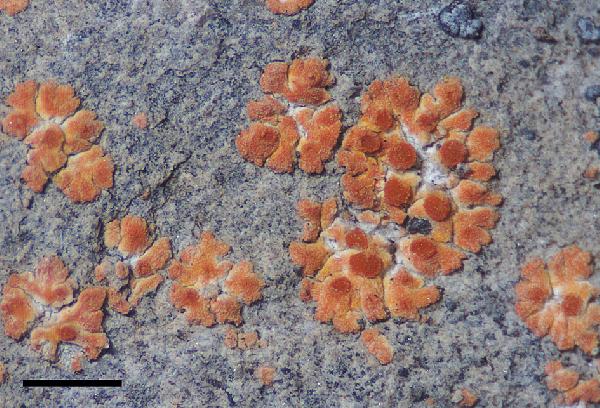Calogaya nana (Gaya) Nav.-Ros. & Cl. Roux
in Roux & al., Bull. Inf. Ass. Franç. Lichén., 47, 1: 30, 2022.. Basionym: Caloplaca arnoldii subsp. nana Gaya - Bibl. Lichenol., 101: 36, 2009
Synonyms:
Distribution:
Description: Thallus crustose-placodioid, episubstratic, 100-200 µm thick, orange-yellow to ochraceous-yellow, more or less abundantly pruinose, forming more or less well-delimited, 0.7-3.5 mm wide rosettes. Central areoles irregular, flat to convex, (0.1-)0.2-0.5(0.6) mm wide; marginal lobes flat to slightly convex, irregularly branched, contiguous and often broadened at tips, (0.13-)0.3-1(-1.2) mm long, 0.1-0.5(-0.6) mm wide at apex. Upper cortex 15-40(-50) µm thick, with an ochraceous-yellow, 6-16.5 µm thick upper layer, and a 10-35 µm thick, hyaline lower layer, scleroplectenchymatous, of irregularly oriented hyphae, with superficial crystals visible under polarized light; algal layer more or less continuous; medulla very lax. Apothecia usually scarce, pseudolecanorine, (0.08-)0.1-0.3(-0.5) mm across, rounded, located on the central areoles or at the lobe bases, at first immersed, then sessile, with an initially slightly concave, then flat to slightly convex, bright orange or ochraceous orange, nearly epruinose, smooth disc, and a paler, persistent proper margin. Proper exciple 20-60 µm wide, of radially arranged hyphae, the outer cells with isodiametrical lumina, the inner ones with elongated lumina; epithecium ochre-orange, 6-14 µm high, K+ purple-red; hymenium colourless, 50-65(-85) µm high; paraphyses sparingly branched in upper part, 1.5-3 µm thick at base, the apical cells 2.5-6 µm wide; hypothecium colourless, sclero-prosoplectenchymatous, subtended by a more or less continuous algal layer. Asci 8-spored, clavate, functionally unitunicate, apically thickened with a broad internal beak, the inner part of apex and external cap I+ blue, Teloschistes-type. Ascospores 2-celled, polarilocular, hyaline, ellipsoid, (6.5-)8-10(-11) x (3-)3.5-5(-5.5) μm, the equatorial thickening (“septum”) 2.5-3.5 μm. Photobiont chlorococcoid. Spot tests: thallus and apothecia K+ purple-red, C-, KC-, P-. Chemistry: thallus and apothecia with parietin (major), fallacinal, emodin, teloschistin and parietinic acid (minor), corresponding with chemosyndrome A of Søchting (1997).Note: on calcareous, often N-facing, vertical surfaces and overhangs protected from rain; known from a few scattered sites in the Alps, outside Italian territory, but perhaps confused with other species. To be looked for in Italy. According to Vondràk & al. (2016), molecular data support the hypothesis that C. nana and C. oblitterata are mere expressions of phenotype plasticity within C. arnoldii.
Growth form: Crustose
Substrata: rocks
Photobiont: green algae other than Trentepohlia
Reproductive strategy: mainly sexual
In underhangs rarely wetted by rain

Predictive model
Growth form: Crustose
Substrata: rocks
Photobiont: green algae other than Trentepohlia
Reproductive strategy: mainly sexual
In underhangs rarely wetted by rain

Predictive model


